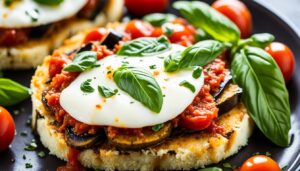Eating raw or undercooked chicken is risky. It can lead to food poisoning. Knowing how to check if your chicken is fully cooked is key to staying safe. You can avoid the dangers linked to undercooked chicken by recognizing the signs.
We’ll show you how to confirm your chicken is well-cooked in this guide. You’ll learn to use tools like a meat thermometer and check the chicken’s texture and color. This info will help you be sure your chicken is safe to eat.
How to Check Chicken Doneness
It’s important to know if your chicken is cooked to avoid getting sick. Look for these signs:
- Use a digital food thermometer to check the chicken’s thickest part. It should be at least 165°F (74°C).
- The chicken’s texture should be firm, looking fibrous or stringy.
- Look at the juices coming out of the chicken. They should be clear or white. Pink or red juices mean it’s not ready.
- Cooked chicken shrinks about 25% from its original size.
- When you cut into the chicken, the inside should be white, very light pink, or light tan.
Key Takeaways
- Knowing how to tell if chicken is cooked is essential to prevent food poisoning.
- A digital thermometer should show the chicken’s inside at 165°F (74°C).
- A well-cooked chicken has a firm texture and clear juices.
- Check for shrinkage and the color inside to be sure it’s done.
- Always follow recommended cooking times for safely cooked chicken.
How to Check Chicken Doneness
Making sure your chicken is fully cooked is key to avoiding foodborne illnesses. The best way to know if your chicken is ready is by using a digital food thermometer. It lets you check the chicken’s internal heat accurately.
You should insert the thermometer into the thickest part, like the breast or thigh. These parts must hit at least 165°F (74°C) to kill off any bad bacteria, as the USDA advises.
Aside from a thermometer, you can also check if your chicken is done by touching it. It should feel firm. Notice the juices too; if they are clear or slightly white, that means your chicken is probably cooked well.
Also, cut into the chicken to see if the meat is white or just lightly pink inside. But remember, color alone doesn’t tell you everything. Always use a thermometer to be sure.
Tip: For a precise temperature, make sure the thermometer doesn’t hit bones or fat. After waiting 30 seconds, you’ll get an accurate reading.
By following these tips about temperature, texture, juices, and color, your chicken will be safely and perfectly cooked.
Using a Digital Meat Thermometer
A digital meat thermometer is key for cooking chicken right. Whether it’s a whole bird or pieces, this tool ensures your chicken is perfectly done. It gives accurate temperatures, so you can serve your chicken with confidence.
There are two kinds of digital meat thermometers for checking chicken:
1. Instant-Read Thermometer:
An instant-read thermometer quickly checks your chicken’s temperature. Use it near the end of cooking. Just put the probe in the thickest part and wait a few seconds. These thermometers are easy to carry and use.
2. Leave-In Thermometer:
A leave-in thermometer watches your chicken’s temperature as it cooks. Its probe stays in the chicken in the oven or grill. This way, you can see the temperature without opening the oven. Leave-in thermometers show the temperature outside the oven, making it simple.
It’s important to make sure your thermometer is accurate. Regularly calibrating it is key. To test it, put the probe in ice water. It should show 32°F (0°C). If not, check the instructions to fix it.
Remember: The digital meat thermometer is a sure way to know if your chicken is done. Don’t just look at its color or texture. They can fool you. Instead, use a thermometer for perfectly cooked chicken every time.
Finding the Thickest Part of the Chicken
Knowing the thickest part of the chicken is key for cooking it right. This matters a lot if you want your chicken cooked well and evenly. Usually, the breast and thigh are the thickest parts.
The chicken breast is on the chicken’s front. It’s lean and tender. It’s also very popular because you can cook it in many ways. The thigh is on the back and is a bit fattier. This makes it juicier and more flavorful.
To check if your chicken is done, always check the thickest part. This part takes the longest to cook. If it’s at the right temperature, the whole chicken will be perfectly cooked.
Use a meat thermometer in the breast or thigh to find the internal temperature. It should be at least 165°F (74°C) to be safe.
Here’s a quick summary of the thickest parts of different chicken cuts:
| Chicken Cut | Thickest Part |
|---|---|
| Whole Chicken | Breast or Thigh |
| Chicken Breast | Center |
| Chicken Thigh | Center |
| Chicken Leg | Drumstick |
Remember, the thickest part tells you if the chicken is cooked. By focusing here and using a thermometer right, you’ll make sure your chicken is done and safe.
Inserting the Thermometer Properly
Checking your chicken’s doneness correctly is crucial. To do so, you need to insert the thermometer the right way. These steps will help you get precise and dependable readings for chicken that’s cooked just right.
- Choose the right thermometer: For the best accuracy, pick a digital meat thermometer. Instant-read thermometers are good for late cooking checks. For ongoing checks, use a leave-in thermometer.
- Locate the thickest section: The thickest chicken part is the best spot for the thermometer. This could be the breast or thigh, often near the center.
- Avoid fat and bone: Keep the thermometer away from fat or bone to avoid wrong readings. Stick the thermometer into the chicken’s meaty areas.
- Depth of insertion: For a correct reading, insert the thermometer 2 inches deep into the chicken’s thickest part.
- Wait for the reading: After inserting it, wait for about 30 seconds. This ensures you get an exact temperature.
Using the right thermometer insertion methods ensures you understand your chicken’s real internal temperature.
Not sure how to correctly insert the thermometer? It’s a good idea to look at the manufacturer’s instructions or find advice from trusted cooking guides.
With the proper knowledge on thermometer use, you’re on your way to making perfect chicken every time.
| Proper Technique for Inserting Thermometer | Depth of Insertion | Avoiding Fat and Bone |
|---|---|---|
| Choose the right thermometer | Use a digital meat thermometer for the most accurate results | Be cautious not to touch any fat or bone |
| Locate the thickest section | Insert the thermometer into the thickest part of the chicken | Aim for the meaty portion of the chicken |
| Depth of insertion | Insert the thermometer about 2 inches (5.1 cm) | |
| Wait for the reading |
Checking the Texture of the Chicken
Checking if chicken is done is important. When it’s raw, it feels rubbery. Once it’s cooked well, it becomes firm and springy.
To test if your chicken is cooked, poke it in a thick spot without bones. If it feels firm and springs back, it’s probably done. Cooked chicken looks fibrous or kind of stringy.
By testing the texture, you make sure your chicken is perfectly cooked. This makes for a tasty meal.
“The texture of cooked chicken is crucial in figuring out if it’s done. A firm texture means the chicken is fully cooked and safe.” – Chef Sarah Johnson
Observing the Juices
Checking the juices is a key test to see if chicken is ready. Clear or slightly white juices mean it’s cooked and safe. But, if the juices are pink or missing, the chicken isn’t done yet. Pink juice or no juice shows the chicken might be undercooked, risking foodborne illnesses.
If unsure, cut into the chicken’s thickest part to see the juice color. If you see pink or red, it needs more cooking time.
Looking at the juice color helps make sure your chicken is fully cooked and safe to eat.
| Juice Color | Implication |
|---|---|
| Clear or white-ish | The chicken is thoroughly cooked and safe to eat. |
| Pink or red | The chicken is undercooked and needs more time to cook. |
| No juices or dryness | The chicken may be undercooked and needs further cooking. |
By paying attention to the juice color, you ensure your chicken is perfectly cooked. This way, you lower the chance of foodborne illnesses and serve a tasty, safe dish.
Noting the Shrinkage
When you cook chicken, remember that it shrinks. This happens because the moisture and fat in the chicken evaporate. So, the cooked chicken ends up about 25% smaller than its raw size.
The shrinkage varies with the initial moisture and fat content. Skinless, boneless chicken breasts shrink less than fattier chicken thighs.
To show how much chicken shrinks, here’s a table:
| Cut of Chicken | Raw Weight | Cooked Weight |
|---|---|---|
| Boneless, Skinless Chicken Breast | 8 oz | 6 oz |
| Chicken Thigh | 6 oz | 4.5 oz |
| Whole Chicken | 4 lbs | 3 lbs |
This table shows weight is lost when cooking. This is natural. Just make sure the chicken reaches the right internal temperature.
Watching chicken shrink while cooking shows how much moisture and fat is lost. It helps plan meals and portions.
Checking the Internal Meat Color
To check if chicken is done, cut into the thickest part. You should see white or light pink meat. Make sure there are no bright shiny pink spots. These could mean the chicken isn’t fully cooked.
Chicken might look slightly pink even if it’s cooked. Always use a thermometer to be sure it’s done. The color can change based on how you cook it or what you season it with. But the main way to tell if chicken is safe is by its temperature.
Make sure your chicken reaches at least 165°F (74°C) with a meat thermometer. When it hits this temperature and has the right color, it’s safe to eat and will taste great.
Chicken Doneness Temperature Chart
| Chicken Part | Safe Internal Temperature |
|---|---|
| Breast | 165°F (74°C) |
| Thigh | 165°F (74°C) |
| Drumstick | 165°F (74°C) |
| Whole Chicken (unstuffed) | 165°F (74°C) |
| Whole Chicken (stuffed) | 165°F (74°C) |
Double-Checking the Cooking Time
Cooking chicken right is key to making it taste good. Following the cooking time closely helps. Whether it’s from a recipe or your past tries, timing is everything for great chicken.
For boneless chicken breasts, cook them for about 35-45 minutes at 350°F (177°C). But don’t just watch the clock. Always check the chicken’s internal temp. Make sure it hits at least 165°F (74°C) to be safe to eat.
Cooking a whole chicken takes a bit longer, around 1 hour and 40 minutes. Like with breasts, it’s smart to use a thermometer. This ensures the chicken is cooked through.
If you’ve got chicken pieces with bones, like thighs or drumsticks, cooking times can change. Stick to your recipe’s advice or use a thermometer to know when it’s done.
Frozen chicken needs more time in the oven, about 50% longer than if it’s thawed. This tip comes straight from the USDA to make sure your chicken is well-cooked.
These tips are basic guides because chicken sizes and thickness can affect cooking. For perfectly cooked and safe chicken, always double-check with a meat thermometer.
Chicken Cooking Time Chart (approximate)
| Chicken Type | Recommended Cooking Time |
|---|---|
| Boneless Chicken Breasts | Approximately 35-45 minutes at 350°F (177°C) |
| Whole, Unstuffed Chicken | Approximately 1 hour and 40 minutes at 350°F (177°C) |
| Bone-in Chicken Pieces (Thighs, Drumsticks, etc.) | Cooking time may vary. Check internal temperature. |
| Frozen Chicken | Cook for approximately 50% longer than thawed chicken. |
Preventing Undercooked Chicken
To stay safe, it’s key to cook chicken well and avoid cross-contamination. By doing so, you keep your chicken meals safe and guard against foodborne illnesses. This protects you and your loved ones.
Using a Meat Thermometer for Proper Cooking Temperature
Using a meat thermometer is a top method for ensuring chicken isn’t undercooked. This tool lets you check if your chicken is cooked through. It helps avoid harmful bacteria.
For an accurate read, put the thermometer in the chicken’s thickest part. Avoid bones or fat. The temperature should be at least 165°F (74°C). This is the safe level for chicken.
Preventing Cross-Contamination with Separate Cutting Boards
Raw chicken can contaminate other foods or areas. Using separate cutting boards for chicken and other foods helps avoid this. It’s a good way to keep harmful bacteria at bay.
Clean and sanitize these boards and any tools used on raw chicken right after. This prevents spreading bacteria to other spots or foods.
Thoroughly Cleaning and Sanitizing Surfaces and Utensils
It’s crucial to clean and sanitize everything after handling raw chicken. Wash all used surfaces, cutting boards, utensils, and knives with hot, soapy water. This fights cross-contamination and keeps food safe.
You might also want to use a food-safe sanitizer or a bleach mix. Follow the directions for correct use and mixing. This ensures everything is properly disinfected.
Safe Cooking Practices to Prevent Undercooked Chicken
| Safe Cooking Practices | Benefits |
|---|---|
| Use a meat thermometer | Ensures chicken reaches proper cooking temperature for safety |
| Separate cutting boards for chicken and other foods | Prevents cross-contamination |
| Clean and sanitize surfaces and utensils | Eliminates bacteria and reduces the risk of foodborne illnesses |
Following these safety tips helps you enjoy chicken that’s not only tasty but also fully cooked and safe. This way, you guard against the dangers of undercooked chicken. This ensures your meals are delicious and safe.
Conclusion
Making sure your chicken isn’t undercooked is key to avoid food poisoning. You can cook chicken just right by following easy steps. This keeps your family safe from bad bacteria.
Use a digital meat thermometer to check if your chicken is fully cooked. Put it in the thickest part, avoiding fat and bone. Then, wait a few seconds to see the temperature.
Also, look at the chicken’s texture and color. It should be firm and bounce back if you touch it. The juices should be clear or slightly white. This means it’s fully cooked. Cutting into the thickest part should show white or light pink meat inside.
Finally, it’s important to use the right cooking times and temperatures. Every type and size of chicken needs a different cooking time to be safe to eat. By doing these things, you can stop food poisoning and always have perfectly cooked chicken.





